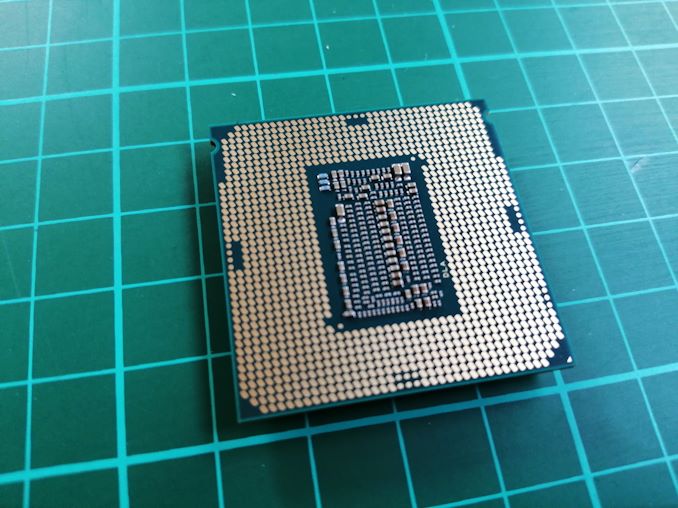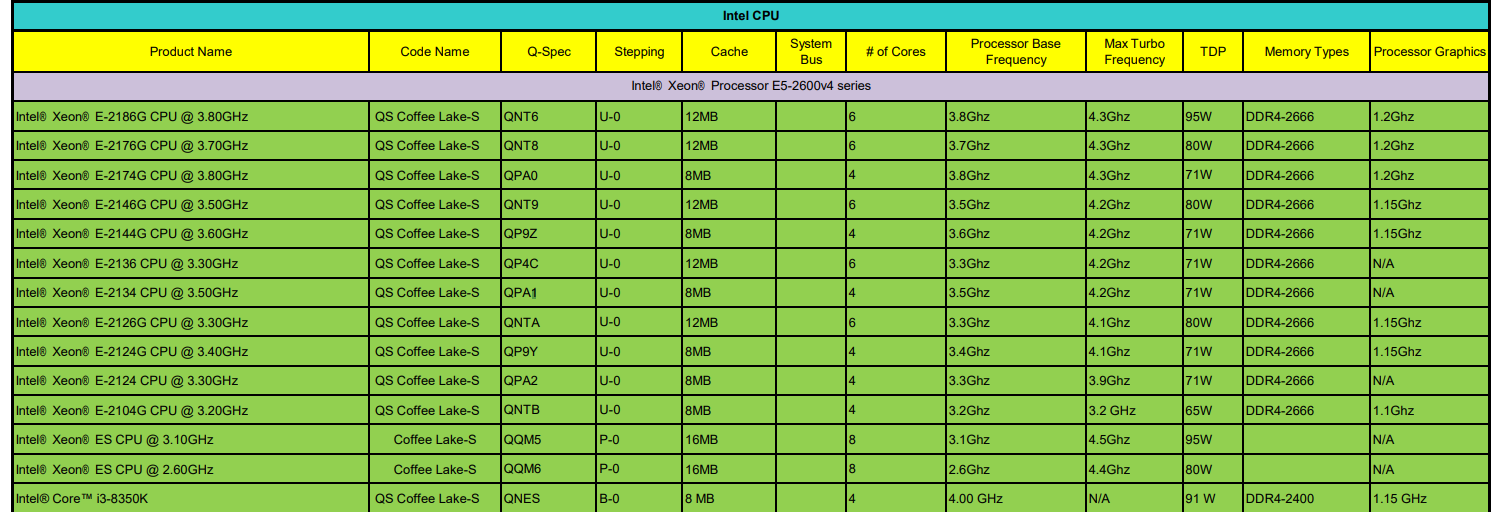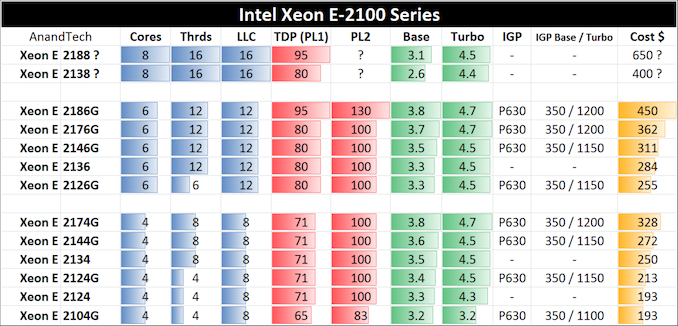Intel Has 8-Core Xeon-E at Engineering Sample Stage
by Ian Cutress on November 26, 2018 12:01 PM EST
One of the interesting omissions from the re-release of Xeon E a couple of weeks ago were the 8-core versions. Intel reiterated its 4-core and 6-core parts, and given the recent release of 8-core processors for consumers we were expecting to see 8-core parts hit the primetime for the commercial market as well. Intel doesn’t officially comment on potential future parts, however one of Intel’s partners has a pair of Xeon E 8-core processors listed in the QVL section of one of its new C242/C246 motherboards.
The new processors are listed as ‘ES’, or engineering samples. Normally the final stage ES processors, we believe to be called ‘ES1/ES2’ parts in Intel internal lingo, are the step before full commercial products, listed as QS. These parts have an almost full range of specifications listed, as follows:
Neither parts have names listed in the QVL list, although we hazard a guess that if they both follow the current naming scheme for Xeon E, the top end model without integrated graphics will be the E-2188 and the secondary one will be the E-2138. This means that E-21 for the family, the final digit for the number of cores, and the third digit for its position in the stack.
The top part shows an 8-core processor with a 3.1 GHz base frequency, a 4.5 GHz turbo frequency, and a 95W TDP. It has 16 MB of L3 cache (2MB/core), is listed as the P-0 stepping, and it looks like the memory frequency isn’t finalized yet, although we suspect it to be DDR4-2666, supporting ECC UDIMMs. Pricing isn’t listed, but going by previous highest core count Xeon E parts, we suspect this to be in the $650 price range.
The other 8-core part has a 2.6 GHz base frequency, a 4.4 GHz turbo frequency, and an 80W TDP. The lower base frequency is in part in conjunction with the lower TDP. This processor also does not have integrated graphics, nor a supported memory listed, but also has 16 MB of L3 cache.
Timeline for availability is unknown. However, reaching ES stage is usually a good sign that these processors will come to market soon.
Related Reading
- Intel Xeon E Six-Core Review: E-2186G, E-2176G, E-2146G, and E-2136 Tested
- The Supermicro X11SCA-W Motherboard Review: For Entry Level Xeon
- ASRock Launches C246M WS Micro-ATX Motherboard for Xeon E CPUs
- Intel Launches Coffee Lake Xeon E (Entry): The Next-Gen E3-1200












19 Comments
View All Comments
Eletriarnation - Monday, November 26, 2018 - link
Considering that currently the only way to get an 8C/16T processor from Intel outside HEDT is to buy the $550 i9, I will be a little bit surprised if they put out an 8C/16T Xeon E at ~$400 even with a slightly lower clock speed. My wild guess is that either these are going to take a while to come out or we're looking at prices more like 500/750 for the low/high 8C models.descendency - Monday, November 26, 2018 - link
With this being a Xeon E part, I'd be shocked at <$600. I'd be less shocked at $1000. Xeon parts are priced well above their consumer counterparts.HStewart - Monday, November 26, 2018 - link
I think especially in last year or so it is a common misconception that Xeon's are more expensive. This is also a single CPU workstation CPU and I be really curious about performance difference between it and HEDT part - especially it base on scalable architecturemode_13h - Tuesday, November 27, 2018 - link
It's pretty clearly just a Xeon flavored i9-9900. As with the Xeon E 2186G vs. the i7 8700K, you can expect this Xeon E to perform a bit worse than its mainstream desktop counterpart.ilt24 - Monday, November 26, 2018 - link
The Xeon E parts aren't priced like the larger core count Xeons. For example the E-2146G (6 core/12 thread) 3.5Ghz/4.5Ghz_maxturbo 80W with a UHD 630 GPU is priced at $311 while the i7-9700K (6 core/12 thread) 3.6Ghz/4.9Ghz_maxturbo 95W with a UHD 630 GPU is priced at $374. Note prices are Intel's list.for a comparison see: https://ark.intel.com/compare/186604,134866
Alsw - Monday, November 26, 2018 - link
Ah but don't forget that in order to have a Xeon with any new pc you have to buy Windows Pro for Workstations 4 Cores+ now this is about an extra £100 in the UK. For the up to 4 Cores version it is more like £30 extra, not sure that played into the pricing but given that single socket workstations are unlikely benefit from any of the additional features of pro for Workstations it is an odd tactic from Microsoft. Not sure there is any charge for AMD but then not seeing big OEM workststions using those CPUs...yetmode_13h - Tuesday, November 27, 2018 - link
Who would waste a perfectly good workstation by running Windows on it? Windows is only for gaming, and Linux is even making inroads there.Alsw - Tuesday, November 27, 2018 - link
Ha, well the vast majority of the market running professional applicaitons such a CAD, FEA, CFD etc , there is a reason Microsoft have done this, the market will pay it as in the grand scheme vs the license costs of the actual software you are running on it, it is still fairly small.mode_13h - Wednesday, November 28, 2018 - link
I figured, but couldn't resist.A lot of professional applications are supported on Linux, BTW.
nivedita - Thursday, November 29, 2018 - link
Nope. You need Windows 10 Pro for Workstations if you want more than 2 sockets not cores. Windows 10 Pro supports up to dual-socket xeons.